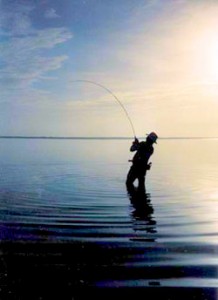 I remember the first trip I ever made to a fly shop to get my first rig. It was a pretty straight forward process when it came to choosing a rod, reel, waders, and boots.
I remember the first trip I ever made to a fly shop to get my first rig. It was a pretty straight forward process when it came to choosing a rod, reel, waders, and boots.
Then he started asking me about lines, and that’s when I got lost!
I’ve since learned fly line isn’t really as complicated as I thought at the time. Let’s break it down and make things simple so you don’t get the shock that I did my first time to the fly shop.
Two Types Of Fly Line
For our purposes here, we are going to look at two types of fly line. These are floating lines, and sinking lines.
The name says it all in those two lines, but, there are a few more elements to understand about fly line construction.
The Fly Line Taper
The taper of a fly line will directly dictate the way it shoots, turns over heavy flies, presents small flies, and how well it casts at long and short distances.
The line taper is a result of varying degrees of coating thickness. Some parts are thicker, some are thinner. There are two different main types of tapers—weight-forward, and double-taper.
Double taper lines are a good, versatile, and relatively inexpensive choice for most short and medium range fishing situations. Depending on where you live and fish however, you will not find a double-taper anywhere. These are not the best lines for giant long distance casts to big fish.
Weight forward lines cannot be reversed on the reel like double taper lines, therefore they have to be replaced more often. The easiest way to tell if you are buying a weight-forward line is to look for the “WF” on the fly line box. Weight forward lines, on top of being great for long distance casting, are usually going to be used for specialty lines as well. Lines made for specific species (bass, steelhead, tarpon, etc.) will almost always be WF. Believe it or not, these are not just clever marketing tricks—these lines actually do make a difference when presenting species specific flies!
Fly Line Leader
Leaders are simple pieces of equipment. They are monofilament lines that attach to the fly line. They are typically between 7 and 12 feet long, and also have a steady taper.
They can be purchased pre-packaged and knotless, and this is exactly what I suggest you do.
Knotless leaders will have a loop on one end that makes it very easy to attach to the fly line. Most premium fly lines also have a loop in the end. With the two loops, you can connect the two lines quickly and easily, no specialty knots required, and you are ready to go.
Tippet
The tippet is the last piece of the fly line puzzle, and it may be the most important. This is the piece that will actually be attached to your fly. On the other end, it will be attached to your leader.
The reason we attach the fly to the tippet as opposed to directly to the leader (which you can do, if you choose) is because when you change flies you will be snipping a piece of that material off every time. If you attach directly to the leader, you will be replacing leaders much more often than you need to.
Tippet material is also used to attach a dropper fly to your main fly. By tying it to the gap area of the main fly, you can attach an additional, different fly underneath. This is a great strategy in deep rivers, and can be especially helpful to figure out what the fish are wanting on any given day.
How To Choose Leader And Tippet Size For Fly Fishing
There is no hard and fast rule here, but I can promise you that if you are throwing tiny flies on giant leaders, you won’t be catching any fish!
When you are just starting out, there is a simple formula for choosing leader and tippet sizes. Take your fly size, and divide by three. So, if you are fishing a size 18 fly, your leader size would be 6. Tippet size would be 6 or less.
This is not a perfect system, but it is a decent guideline for the beginner who just wants to get out on the dang water!
Next time around, we will be taking our final look at fly fishing tackle when we talk about flies.
See ya on the water…